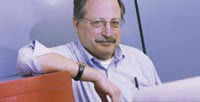Patterns of the Future
UNM researcher creates tools from nanoscale pattern
 Professor Steve Brueck is working hard to stay ahead of the law - Moore's Law, that is. The famous prediction states that the number of transistors per integrated circuit doubles every two years. The semiconductor industry pegs advancements in power directly to Moore's Law, demanding faster, denser processors every 18 to 24 months. That means packing more power onto already small computer chips. Thanks to Brueck, the industry - and science as a whole - is staying ahead of the curve.
Professor Steve Brueck is working hard to stay ahead of the law - Moore's Law, that is. The famous prediction states that the number of transistors per integrated circuit doubles every two years. The semiconductor industry pegs advancements in power directly to Moore's Law, demanding faster, denser processors every 18 to 24 months. That means packing more power onto already small computer chips. Thanks to Brueck, the industry - and science as a whole - is staying ahead of the curve.
Brueck is a UNM professor of electrical and computer engineering, and physics and astronomy. He also serves as the director of UNM's Center for High Technology Materials (CHTM), an interdisciplinary research center at UNM with programs in micro-electronics, optoelectronics and nanoscience. CHTM has been a Center of Excellence for SEMATECH, a consortium of the world’s semiconductor manufacturers.
At CHTM Brueck and a dozen post-doctorate and graduate students work in clean rooms and labs to perfect a process called nanolithography, a way of replicating patterns to unprecedented dimensions. They use customized optical lenses, lasers and measurement instruments to refract beams of light on to photoresists or chemicalpolymers that are sensitive to light. Intensity variations in the light create localized chemical reactions, which result in tiny patterns when the resists are developed. These patterns can define transistors, wires, channels or other features that can be incorporated into larger devices. Brueck’s research spans the entire process of nanolithography, from perfecting the tools and lenses used to create the patterns, to the chemistry that occurs on various substrates.
But what really distinguishes Brueck's research is the size of the patterns he creates. His work is at the nanoscale level, where a nanometer equals one billionth of a meter. This past summer, Brueck and his team made a breakthrough by producing the smallest pattern on record.
"We have the first good patterns at 45 nanometers that I know of in the world. These patterns occur over large areas - up to 10 centimeters, so there are over a million repetitions of the pattern. This is much more than is possible with any other technique. We're able to drive the manufacturing costs way down because of the size and number of repetitions," says Brueck.
For comparison, the electronics industry is currently working at the 90 nanometer node. The International Technology Roadmap for Semiconductors (ITRS), an industry-wide roadmap for semiconductor development, projects that manufacturers won’t reach the 45 nanometer node until 2010. Brueck and his team are clearly pushing the envelope.
Brueck's latest achievement is based on laser interference, the standing wave in laser intensity that is formed when two coherent (i.e., oscillating in lockstep) laser beams are incident on the photoresist. This is directly analogous to the standing wave that forms on a child’s jump rope when you tie down one end and shake the other at just the right frequency. The scale of this intensity pattern is related to the wavelength of the laser beams - the repeat distance for the wave - which is only 200 nanometers for the lasers Brueck uses. And there is one other new trick, dunking the whole experiment in water. Light bends when it enters water, as is familiar to anyone trying to pick up a rock in a pond, and this bending can be harnessed to reduce the size of the printed features.
Kevin Malloy, formerly associate director of CHTM and currently associate dean for research for the UNM School of Engineering, points out that Brueck's research not only produces smaller scale patterns, but the processes he's developing are more economical than current approaches. "The work being done by Steve and his group services a $50-75 billion industry," Malloy says. "Their work will help keep semiconductor manufacturing in the United States."
"Nanoscale lithography is an enabling technology," explains Brueck. "It is a new approach to imaging that has potentially unlimited applications." The "nano tools" Brueck is helping to create could be used for everything from biomedical sensors and gas detectors to mobile communications and improved flat panel displays.
Malloy says that Brueck's research will create opportunities in all realms of science. "That's the importance of Steve’s technology - it provides the capability for everyone to do interesting things. He provides an incredible suite of tools and visionary techniques, not only to the semiconductor industry, but also to biotech, lighting, materials science and other fields as well. And that's why people are so excited about it."
